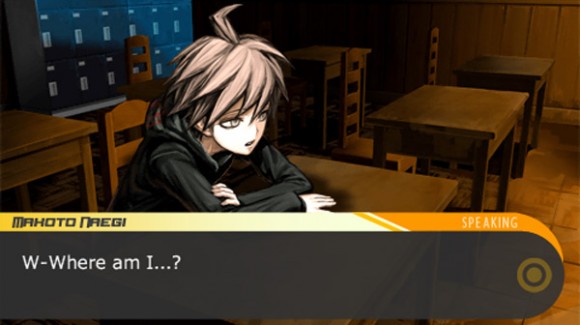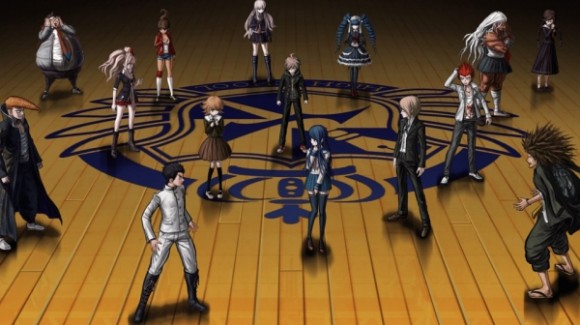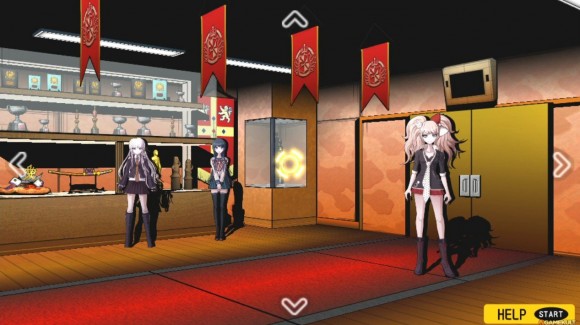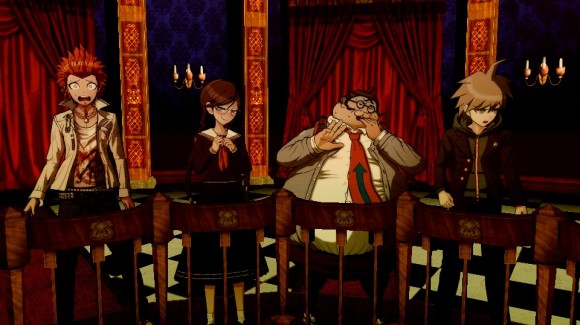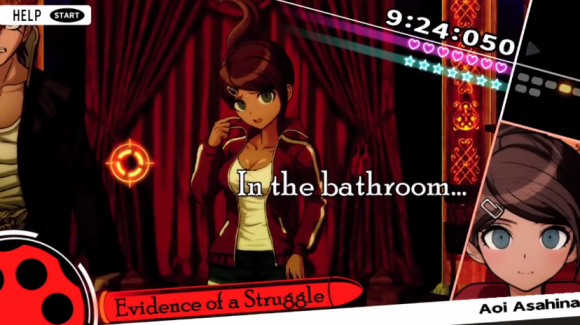If you’re not an old man like me and have stayed with the pulse of the times, you may have already heard of Danganronpa: Trigger Happy Havoc (also called Danganronpa: Academy of Hope and High School Students of Despair). A visual novel released for PSP and smartphones in Japan four years ago. The game also had a fan translation floating around out there, however it didn’t get a North American release until NIS America decided to bring Spike Chunsoft’s title to the Vita earlier this year.
I’ll come right out and say it, at first glance Danganronpa struck me as nothing special. You’re trapped in a crazy messed up high school with every Japanese cliche you’ve come to know from the sweet pop idol, to the tough guy biker, the tsundere, the gothic lolita, the overweight otaku and a half dozen more uninspired cliches.
I scoffed and I scoffed hard. I was unamused, perhaps by my eager willingness now to see the bad in games, or perhaps after years of Persona, Ace Attorney and even Yu-Gi-Oh I’d seen these characters done before, and supposedly done better. The entire opening of the game was meandering, and knowing jumping into the title this would be a murder mystery I frankly couldn’t wait for one of these stale characters to die.
Then I got to my first wish. Which changed my entire perspective on the game.
Before we go into that a brief overview of the story. You, Makoto Naegi, and 14 other kids will be attending the Hope Academy high school for “Ultimate Students.” Each student is the best of the best in their chosen field, be it baseball, fashion, computer programming, biker gang leadership, doujin drawing, punctuality etc. Makoto is the ‘Ultimate Lucky Student’, selected by lottery draw to attend the academy. However considering that it’s more of a prison with no daylight and where the inmates are encouraged to secretly shiv each other by a cookies and cream lookin’ psychotic bear mascot, you have to question how lucky he is.
Mr. bear mascot, or as he’s called, Monokuma gives the 15 kids an ultimatum. Live in peaceful harmony forever trapped in this school, or kill one another to “graduate” and regain their freedom. Monokuma clearly wants you to take the latter option doing everything he can to encourage the students to off the other. However Battle Royale/Hunger Games this is not, think more Law and Order. It’s not enough just to kill your fellow classmate, you actually have to get away with it.
When the bodies start hitting the floor they go hard. After about three or so hours of gameplay I had my first murder investigation on my hands. This consist of investigating a crime scene thoroughly and gathering evidence or as they’re known in Danganronpa “Truth Bullets.” Everything takes place on a 3d plane from a first person perspective, with your fellow classmates represented as 2D cutouts. After you’ve explored every conceivable angle the game automatically ushers you into the murder trial.
As I said this is the part of the game where things get very interesting. Stakes are high, you either have to pinpoint the real killer and send them off to their execution, or you fail and you along with all your classmates save the killer are executed instead. You get a pre-trial setup to review your notes and select your special abilities, then it’s time to start.
It’s Makoto’s word against how ever many of his classmates still stand. You face one another, round table style, as the camera rotates around the room to catch whoever’s speaking. This phase is aptly called the “Nonstop Debate” a timed section where everyone tries to resolve who the murderer is (or in the case of the murderer and your peers who just don’t like you, try and throw you off the trail.) During this phase a series of contradictions and lies pop up during the conversation, and it’s your job to select the proper piece of evidence or ‘Truth Bullet” to catch said contradiction.
These phases are highly interactive. In Ace Attorney you could carefully sift through text to raise your objections and present character arguments. In Dangan Ronpa every event is timed, you have to be super attentive to a conversation or some valuable piece of information will slip right past you. While an argument will “restart” if you missed a bit or bob of evidence, that timer is constantly ticking. Rather than simply raising an objective you have to aim and shoot at a statement, making sure you have the right “round” (Truth Bullet) loaded into your gun.
You’ll encounter White Noise, thoughts meant to throw you off an argument and miss your shot, sometimes you won’t have the right Truth Bullet so you’ll have to grab it by locking on to a peer’s statement and using it as your ammo. It sounds a bit nuts and complicated trying to describe it, but in game it flows quite well.
Successfully ending a Nonstop Debate brings you to a break in the case, where everyone reorganizes their thoughts and you get a chance to either present further evidence or engage in a multiple choice quiz. All of this impacts your “Influence”, which is a fancy and plot relevant way of saying health bar . Lose your Influence and no one gives a damn what you have to say, effectively ending the trial and the game. Just like real life!
It’s during these trials the individual personalities of each character, before just simple cliches, come boiling to the surface. Errbody got sumthin’ say ’bout sumthin during the trials, whether they stand with Makoto or against him they’re going to let their voices be heard. This is the first moment the characters were really colored in for me and that I started to feel invested in the rather large cast.
Each trial also brings to light some very interesting plot twists and story elements related to the characters you interact with. It takes that character’s portrayal, and turns it on its ear, in other words it inverted the very trope it relied on to get the player comfortable with the character. It’s a form of narrative manipulation that worked very well, taking a seemingly simple character and giving them more complicated depth.
Befriending characters before a trial is also important. For starters, you’re going to want to get a bit of backstory and world flavor before these people start being murdered (or become a murderer). Secondly your relationships with characters grant Makoto special abilities that can be used in trials, such as slowing down the timer or giving him more accuracy before firing a truth bullet. Without spoiling it I had the misfortune (…maybe the good fortune???) of befriending the first three characters to bite it without even knowing. I sure knew how to pick ’em.
There’s more to the trials than just the debate and break phases however. There’s the Hangman’s Gambit, where Makoto has to carefully think about his next statement and you play a game of hangman by shooting down letters. After several “acts” pass in a trial you come to your closing argument. Here you get to re-piece the entire crime scene in comic book fashion. The comic book art has its own quirky, vibrant style that’s similar but different to the in-game portraits and cutscenes. After piecing together the closing argument, the comic pages will reenact the entire crime as a sort of trial review for you and your peers, and erasing any doubt as to who the true murderer might be.
But it doesn’t end there! What kind of murder mystery would this be if the killer just quietly went to their fate? The murderer, or one of their allies, will vehemently deny everything you’ve said, which triggers a “boss battle” in the form of a timed rhythm game. Hitting the Vita screen or X button in time to the beat will target all of their lies and contradictions, and pressing Triangle will shoot them all down at once. The murderer tells one final lie that Makoto shatters winning him the case.
I will talk briefly about controls. While this is a Vita title it was created well before the Vita existed. Basically every action in the game as two controls, the directional pad and buttons, or the front and back touch screens of the vita. Touching different areas of the Vita will usually perform a different action in trials, and allow you to more easily explore in investigation and free time modes. That said I largely just stuck to the button control scheme as I found it overall easier to work with.
As epic as trials are you have mixed feelings successfully completing one. On the one hand you’re kind of not dead so that’s a good thing. On the other hand you get to watch the killer’s specially selected punishment and execution based on what kind of “Ultimate” they are (think personal hell). Not to mention everyone who gets killed, murderer or victim, is kind of your friend. Nothing feels like a true victory hence the very fitting theme of “despair” through out the title. Despite the overall grimdarkness of the story, it also manages to be bizarrely humorous at times, such as a Serial Killer doubling up for the part of Class Clown.
The game hints at a larger overall conspiracy, and trust me when I say freaked up things happen over the course of the story. Yes. More freaked up than teenagers killing one another and a psychopathic sadist of a bear meddling with your day to day affairs. It opens up just enough questions to keep your curiosity piqued but without overwhelming you with conspiracy. There’s also tons of goodies to unlock, such as special artwork and a unique mode after you’ve beaten the core game, so there are some nice incentives to keep going.
Now like the Ace Attorney games it’s not really possible to lose a trial, but the timed interactive aspects of the game makes it a surprisingly tense experience. If you have the patience you can dig down to this game’s creamy center and find an experience that is completely set apart from its closest parallels, Ace Attorney and Persona, giving you something unique and not quite done before. It’s also a beefy title, the trial phase alone can take a couple hours to complete, so it’s a nice game to take with you on the road. If you’ve got a visual novel itch and need to give your Vita a workout, or if you’re indeed a fan of those aforementioned titles but need to get your fix before Persona 4 on PSN or Phoenix Wright vs Professor Layton, you could do worse than grabbing yourself a copy of Trigger Happy Havoc: Danganronpa.


